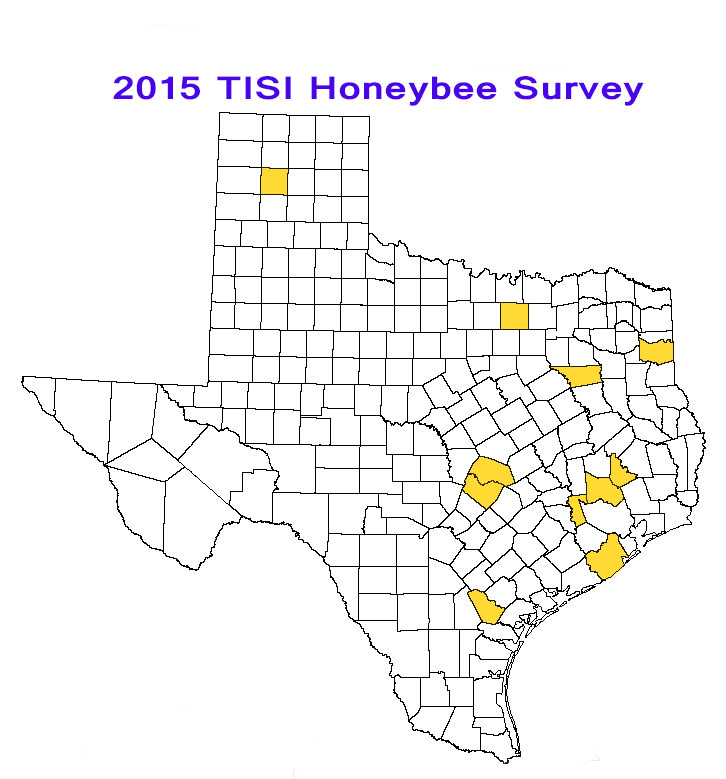


In 2015, TISI received a CAPS (Cooperative Agricultural Pest Survey) program grant to survey for pests and parasites of honeybees in all 11 Texas ecoregions. They travelled to 14 apiaries within 11 counties (pictured right). Dr. Autumn Smith- Herron was able to detect the internal parasites Nosema apis (pictured above, the small "rice-shaped" organisms), which are single-cellular parasites that can cause diarrhea in bees and taint the honey production. Dr. Brian Chapman also detected the presence of the invasive Varroa mites, which are the external parasites of honeybee larvae and adults. They feed on the growing larvae and which the larvae pupate in to adults they suffer from wing disfigurement and even death. Also, we have found small hive beetles in the colonies surveyed.

Another project that TISI is working on is the survey and management of the Red Streaked Leafhopper (RSLH) Balclutha rubrostriata. In 2006, the RSLH was found by Zahniser et al., in Bexar County, Texas. They also found RSLH in museum specimens from Kerr, Kleberg, Hays and Austin Counties. The reason this small pest from Asia is of major concern is that it can carry a phytoplasma that is deadly to sugarcane crops in Thailand and causes 100% crop loss. Since sugarcane is a vital crop for Texas, Louisiana and Florida, TISI decided to survey south Texas sugarcane producing counties and counties that are a "thoroughfare" to Louisiana sugarcane producing parishes.
In 2012, we were able to confirm the presence of the RSLH in Willacy County near sugarcane crops and in several counties leading up to the Louisiana border. Since 2012, we have surveyed 93 counties and 4 Louisiana parishes and have confirmed the presence of the RSLH in all south Texas sugarcane producing counties (Willacy, Hidalgo and Cameron). We have sweep-netted off of various types of grasses and confirmed that the RSLH is able to expand its distribution with King Ranch bluestem (an introduced and invasive grass).
In total, RSLH has been confirmed in 38 counties and one solitary specimen was found in Rapides parish, Louisiana. With the survey portion of this project satisfied, we plan to use the relationship between the RSLH and the King Ranch bluestem to create lures, traps, and other management tools, to prevent the establishment of this leafhopper in Louisiana and Florida. This map shows all counties that we surveyed and has highlighted all counties with positive RSLH collections.
Nylanderia fulva was originally discovered in Texas in 2002. Although it was restricted to a few city blocks at the time of discovery, it has since spread to over 28 Texas counties. In addition, it has moved from urban areas into agricultural settings, is now known to eliminate honey bee colonies, and has moved into pecan orchards. Our resident Crazy Ant Expert, Dr. Danny McDonald, has been monitoring the spread and ecological competitiveness of N. fulva from its introduction in southeast Houston. We continue to work with the pest control industry to identify new products that will aid in the management of N. fulva. Laboratory and field based tests are being conducted on new baits and pesticide sprays. Also, Dr. McDonald is studying the biology of this invasive ant.
In collaboration with the Texas Department of Agriculture, researchers from TISI and the Texas Research Institute for Environmental Studies (TRIES) have sampled counties along the western boundary of the fire ant quarantine zone. Data from this sampling effort has resulted in the discovery of S. invicta from three counties in which it has not been previously reported. This survey remains a long term effort and TISI participated throughout the 2014 field season, determining if new counties were candidates for quarantine.
In 2013, TISI began a project to conduct aquatic surveys on four Texas National Guard Training Facilities. These surveys were designed to document populations of all freshwater molluscs, including the invasive zebra mussel. Water quality parameters were tested and documented in an effort to assess aquatic ecosystem health and maintenance. At the conclusion of the survey, TISI found that native mollusc populations at the training facilities had decline in recent years and the invasive asian clam was also present at several locations. The Texas National Guard manages tens of thousands of acres and TISI continues to help with monitoring for invasive species.